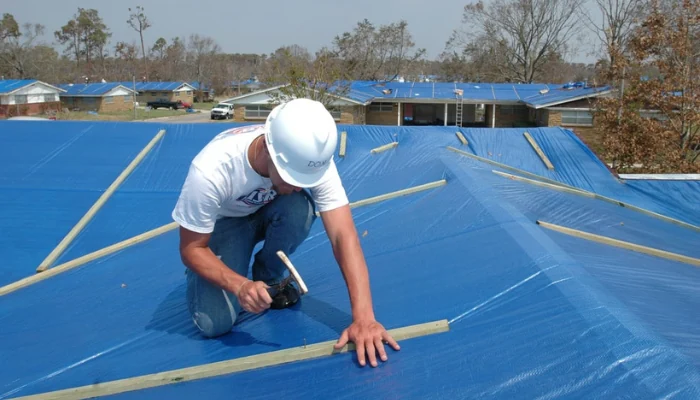Shingle roof storm damage isn’t something you can afford to ignore, especially in Florida. That’s because storm damage spreads fast. A single gust can lift shingles, tear sections loose and leave your roof wide open to the next wave of rain, not to mention the potential cost of shingles storm repair if you delay action.
So, you’ve probably asked yourself: “Is it just cosmetic or is my home at risk?”. Thousands of homeowners in Florida face this exact question every year. And the real danger? It’s what you don’t see right away like hidden leaks, mold buildup and creeping roof storm damage that weakens your structure over time..
According to data from the National Oceanic and Atmospheric Administration (NOAA), Florida experiences over 80 severe storm events annually. Many of those cause storm damage that leads directly to roofing emergencies. That’s why speed matters.
This guide breaks down how to recognize damage, what steps to take immediately, and how installing a professional blue tarp can make the difference between a manageable fix and a full-blown roof replacement.
Don’t wait for the next storm to make things worse. Learn from Prospect Preserve Roofing how to protect your home.
Table of Contents
ToggleShigle Roof Storm Damage in Florida
Storms in Florida don’t play “easy”. Winds rip through yards, trees fall like dominoes and roofs? They take the hit. Shingle roofs, especially, are the first to show signs when the weather turns ugly.
Here’s how storm damage usually starts:
- Strong winds can lift shingles. One edge goes up, water gets in. That’s all it takes.
- Heavy rain doesn’t ask for permission. If even one shingle is loose, rain will sneak under and rot the wood.
- Hail is like a hammer. Even small pieces crack the surface. Over time, this adds up to serious roof storm damage.
- Flying debris knocks off shingles, breaks flashing, and leaves open paths for water to enter.
Florida averages over 60 thunderstorm days per year in many counties. That means your roof sees more action than most people’s cars. And here’s the catch: sometimes you don’t see the damage right away. That’s right, it can look fine from the ground. But weeks later, you’ll spot a ceiling stain or hear a drip at 3 a.m. when is indeed too late.
That’s why If you don’t check for shingles storm repair needs right after a storm, damage can escalate fast. You need to inspect it or have Protect Preserve Roofing take a quick look. One visit could save you thousands.
Spot the Signs of a Shingle Roof Storm Damage
Some signs hit you in the face – even literally. Others hide until it’s too late. The key is knowing what to look for before the damage spreads.
Here’s what you need to watch out for:
- Missing or loose shingles: Obvious, but easy to miss from the ground. If you see bare spots or exposed underlayment, that’s trouble.
- Lifted edges: Even if the shingle looks “okay,” wind can lift a corner and break the seal. Water gets under and starts the rot.
- Granules in the gutter: Shingles have a gritty top layer. If you spot a pile of it in your downspout, your roof is losing its armor.
- Water stains on the ceiling: A yellow spot inside your house means moisture made it through. By this point, the roof’s already been compromised.
- Loose flashing or metal parts: Around chimneys, vents, and valleys. One piece out of place opens the door to leaks.
Every one of these could point to roof storm damage that requires fast attention or even full shingles storm repair.
Not sure if what you’re seeing is a real problem? That’s where professionals like Protect Preserve Roofing step in. One quick inspection can tell you what’s damaged and what can still be saved.
Steps to Take Regarding Shingle Roof Storm Damage

A storm just passed. You’re standing in the yard, looking up at your roof, wondering what to do next. You don’t need to, but don’t wait either. Quick action can mean the difference between a patch-up and a full replacement.
Here’s what to do, step by step:
- 1. Stay safe: Don’t climb on the roof right after a storm. Wet shingles are slippery, and the structure may be weakened. If in doubt, wait for help.
- 2. Document the damage: Use your phone to take clear photos of anything visible like missing shingles, fallen branches, ceiling stains (the storm damage). These will help with insurance and contractor estimates.
- 3. Check inside: Look for leaks, water stains, bubbling paint, or musty smells. Damage isn’t always where you expect it. Start with the attic if you can.
- 4. Cover the damage: If rain is in the forecast and your roof is exposed, cover it fast using a blue tarp. This is where a blue tarp becomes your best friend. And no—throwing a tarp on the roof isn’t enough. It needs to be secured right.
- 5. Call the pros: Professionals like Protect Preserve Roofing install blue tarps quickly and securely. They know where to place them, how to anchor them, and how to avoid making things worse.
Reminder from Prospect Preserve Roofing: Insurance often covers shingles storm repair, but only if you take steps to prevent further damage. That means acting fast and documenting everything.
Why a Blue Tarp Matters for a Shingle Roof Storm Damage?
If storm damage exposed your shingle roof, don’t let the next storm make it worse. A professionally installed blue tarp stops leaks, protects your structure, and buys you time.
However, not all tarps – or installations – are equal.
Why a blue tarp matters?
- It blocks water fast: One uncovered hole is all it takes to flood drywall, insulation, and electrical systems.
- It protects from UV damage: Florida sun can cook exposed roofing materials in just a few days. A tarp shields what’s left.
- It gives you breathing room: Repairs take time. Schedules get booked. A blue tarp keeps your home protected while you plan your next step.
What makes a good installation?
Slapping a tarp on the roof with bricks or duct tape won’t cut it. It needs to be installed very well:
- Tight and smooth, no flapping, no sagging.
- Securely fastened, using wood strips, screws, and weather-resistant techniques.
- Properly placed, covering the damaged area plus extra space for runoff.
That’s why professional help matters.
At Protect Preserve Roofing, blue tarp installation is what we do every day, especially for Florida homeowners after serious storms. We know how to do it right, fast and safely.
Florida Storm Season: Common Risks and Roofing Tips
Living in Florida means dealing with more than sunshine. From June to November, storm season hits hard. And your shingle roof? It’s on the front line.
Common roofing threats in Florida
- High winds: These rip up shingles and loosen flashing. Once that protective layer is gone, rain follows fast.
- Torrential rain: Water piles up in minutes. One small gap in your roof can turn into soaked insulation and stained ceilings.
- Flying debris: Tree limbs, roofing tiles from nearby homes, even loose patio furniture – all of it can hit your roof like a hammer.
- Hail: Not always big, but always dangerous. Hail weakens the surface of shingles and shortens your roof’s lifespan.
Smart tips to stay ahead
- Inspect after every storm: Even if everything looks fine, subtle damage builds up.
- Keep trees trimmed: Branches over your roof are bad news when wind hits.
- Clean your gutters: Blocked drainage adds pressure and increases leak risks.
- Install a blue tarp early if needed: Waiting too long invites water damage. If there’s a hole or missing shingles, act now.
Here in Florida, you don’t wait and see. You prepare and prevent. That’s what homeowners who avoid big repairs do differently.
Operation Blue Roof vs. Professional Blue Tarp Installation

We have put together a comparative table for you, as we are here to help you with the best information at all times. Check it out below:
| Feature | Operation Blue Roof (FEMA) | Professional Service (Protect Preserve Roofing) |
|---|---|---|
| Cost | Free (if eligible) | Paid service, cost varies by damage and size |
| Response Time | Often delayed due to high demand during disasters | Fast – typically same-day or next-day response |
| Eligibility | Limited (primary residences only) | Available for all property types |
| Installation Quality | Basic and temporary | Professionally reinforced, built to withstand Florida storms |
| Customization | Standardized application | Tailored to your roof’s structure and damage |
| Includes Inspection | No | Yes, with damage assessment and repair planning |
| Follow-up Support | Not included | Ongoing service, full repair guidance |
| Peace of Mind | Temporary relief | Lasting protection, expert execution |
Which one should you trust? Operation Blue Roof can help in an emergency or when budget is tight, but accuracy, speed and exceptional service delivery are essential. That’s why Protect Preserve Roofing is the safest choice.
Conclusion: Why Protect Preserve Roofing Is the Best Choice in Florida?
When storms tear through your neighborhood and your shingle roof takes a hit, the clock starts ticking. Every hour you wait increases the risk of leaks, mold and costly repairs. You don’t need uncertainty, you need action.
That’s where Protect Preserve Roofing steps in.
We don’t show up late, don’t take shortcuts. We tarp your roof right, the first time.
Here’s why Florida homeowners trust us:
- Speed you can count on: We respond fast to keep your home dry and secure.
- Florida-focused expertise: We know what local storms do to roofs because we deal with them every week.
- Reliable materials, solid installs: Our blue tarps are thick, reinforced, and professionally anchored to last through sun, wind, and rain.
- Real people, real service: You won’t deal with a call center. You’ll talk to a team that knows your street, your city, and your storm season.
We’ve helped hundreds of families protect their homes after storms and we’re ready to help yours.
Don’t wait for the next storm to test your roof again. Click here to request your fast tarp install and price or here to a roof inspection from Protect Preserve Roofing.
Let our experts secure your home fast, safe and stress-free.










